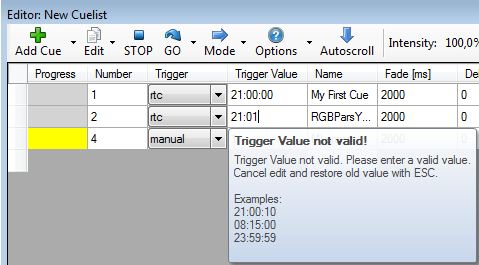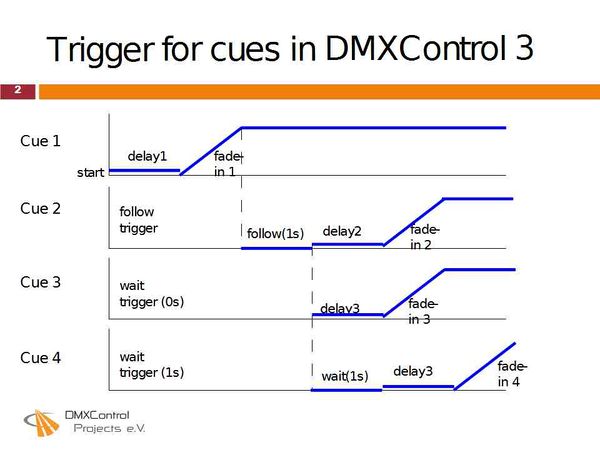Overview
Cue lists are the best means to control your show. In this lesson we explain how to define the sequence and the flow of scenes by triggers.
Lecture 11: Trigger in cue lists
In previous lesson we learnt how to create cues and scene lists. Now we are familar with most of the attributes of scene list, but some more explanation about the trigger is nessecary. The default trigger is "follow", i.e. the next cue will be started after the previous one is faded-in.
Important: When you change the trigger type, you need to apply the changes with Enter.
But there are some other types of triggers, the following table informs you about its behaviour.
| Type | Example format | Description |
|---|---|---|
| manual | (opt) 3 | use GO to fade in next cue
optional: fade in cue after 3 GO presses, default is 1 |
| follow | 5s | wait until the previous cue is faded in, then the countdown is started |
| wait | 5s | wait time countdown starts when wait or follow of previous cue is completed |
| timecode | 00:26:05 | expects external timecode information |
| rtc | 13:00:00 | real time clock, fade in a cue at a specified time |
| beat | (opt) 3 | connect in Input Layer panel the "manual beat" output per Drag & Drop with "Beat" input of scene list
optional: fade in cue after 3 beats, default is 1 |
In case you type a wrong format into the trigger value field you will get some hints about the expected input syntax. See the example for the "follow" type.
| |
Type in combined time information without "blank" character, e.g. 1m20s |
Here is the example for the timecode selection.
Currently the time code from Digital Enlightenment Mediacenter [1] is supported only. Support of other time codes will follow.
Use of beat trigger
If you want to keep off your scenes beat controled, you need to select the trigger beat . Template unused
Template:Bild mit Unterschrift
Now you should inform the Cue List what is the source of Beat Signal (Manual Beat/Audioanalyzer....) Therefore you have to make an assignment Input Assignment , where you must drag an item per Drag&Drop to the beat entry of the cue list.
Summary
Following figure shows the dependency and capability of mixing several trigger types:
- Each cue has its delay-time (before the fade in start) - delay1 to delay4
- Cue2 has a follow-trigger of 1s, it starts 1s after the fade in the previous cue is completed
- Cue3 has a wait-trigger, but 0s. Thus cue3 starts immediately after the follow the previous scene has expired
- Cue4 also has a wait-trigger (1s). So it will wait for 1s after the wait (0s) of the previous scene has expired.
Excercise
- Test a mix of "follow" and "wait" triggers in one scene list
- Use a tool providing timecodes (DE MediaCenter) and test a scenelist that is completely based on timecodes
Certificate
I have understood the topics of this lecture and want to continue with next course: Lesson 12



